Business Communication Presentation: Effective Strategies and Analysis
VerifiedAdded on 2022/09/03
|10
|1959
|22
Presentation
AI Summary
This assignment is a comprehensive analysis of business communication, presented in a structured format. The presentation covers the essential components of effective communication, including the communication process, various channels (face-to-face, broadcast media, electronic, and written), and the differences between formal and informal communication networks. It also delves into the barriers that can hinder communication, categorized as verbal and non-verbal, with examples such as inadequate knowledge, ambiguity, inappropriate expressions, and emotional distractions. The presentation emphasizes the importance of clear, concise, and appropriate communication in achieving both individual and organizational goals. The student references various scholarly articles and resources to support the concepts discussed, culminating in a conclusion that reinforces the cyclical nature of effective communication and the need to avoid barriers. The assignment includes an annotated script and a reflection on personal development throughout the project, demonstrating a practical application of communication theories and a commitment to improving presentation skills.
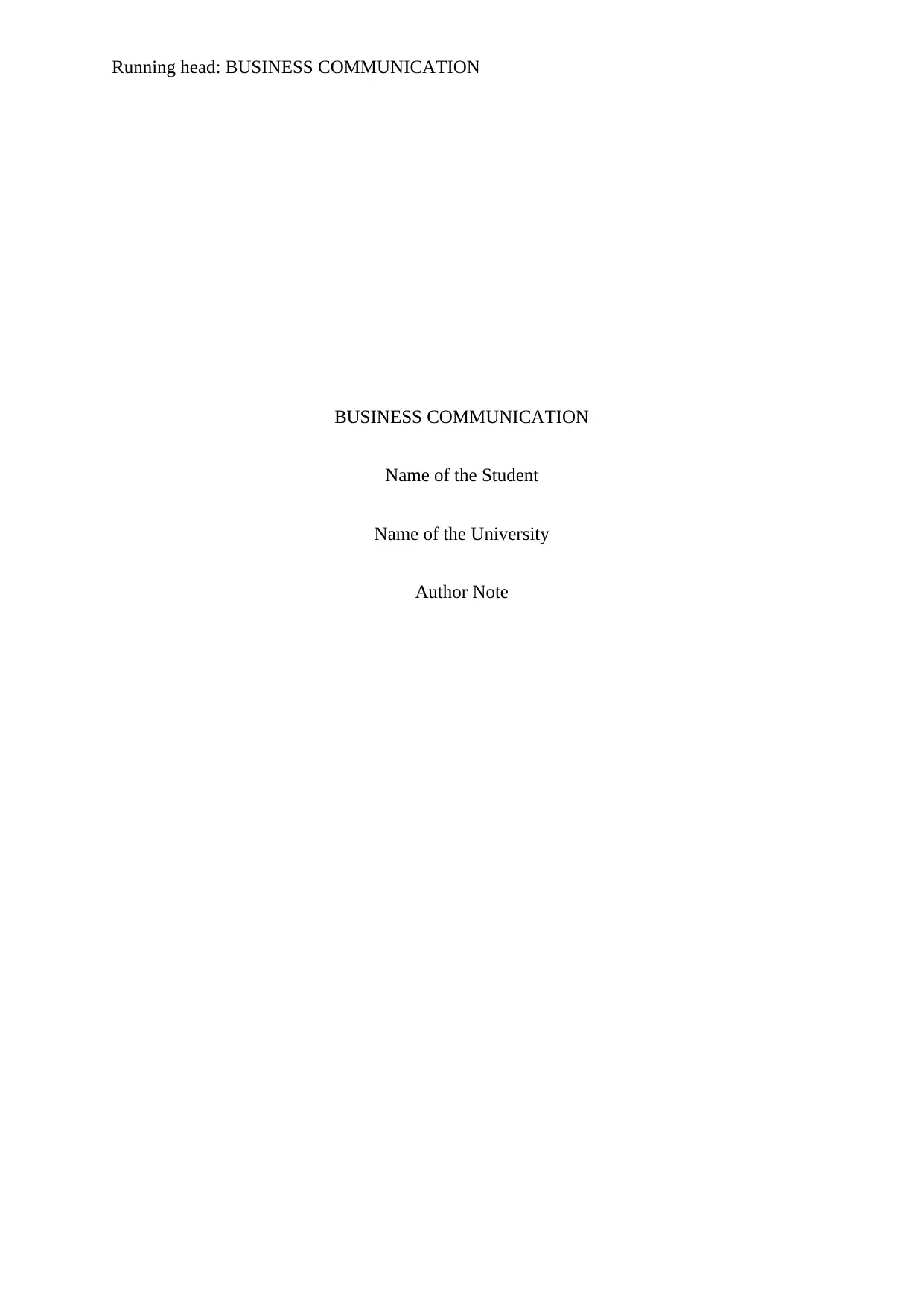
Running head: BUSINESS COMMUNICATION
BUSINESS COMMUNICATION
Name of the Student
Name of the University
Author Note
BUSINESS COMMUNICATION
Name of the Student
Name of the University
Author Note
Paraphrase This Document
Need a fresh take? Get an instant paraphrase of this document with our AI Paraphraser
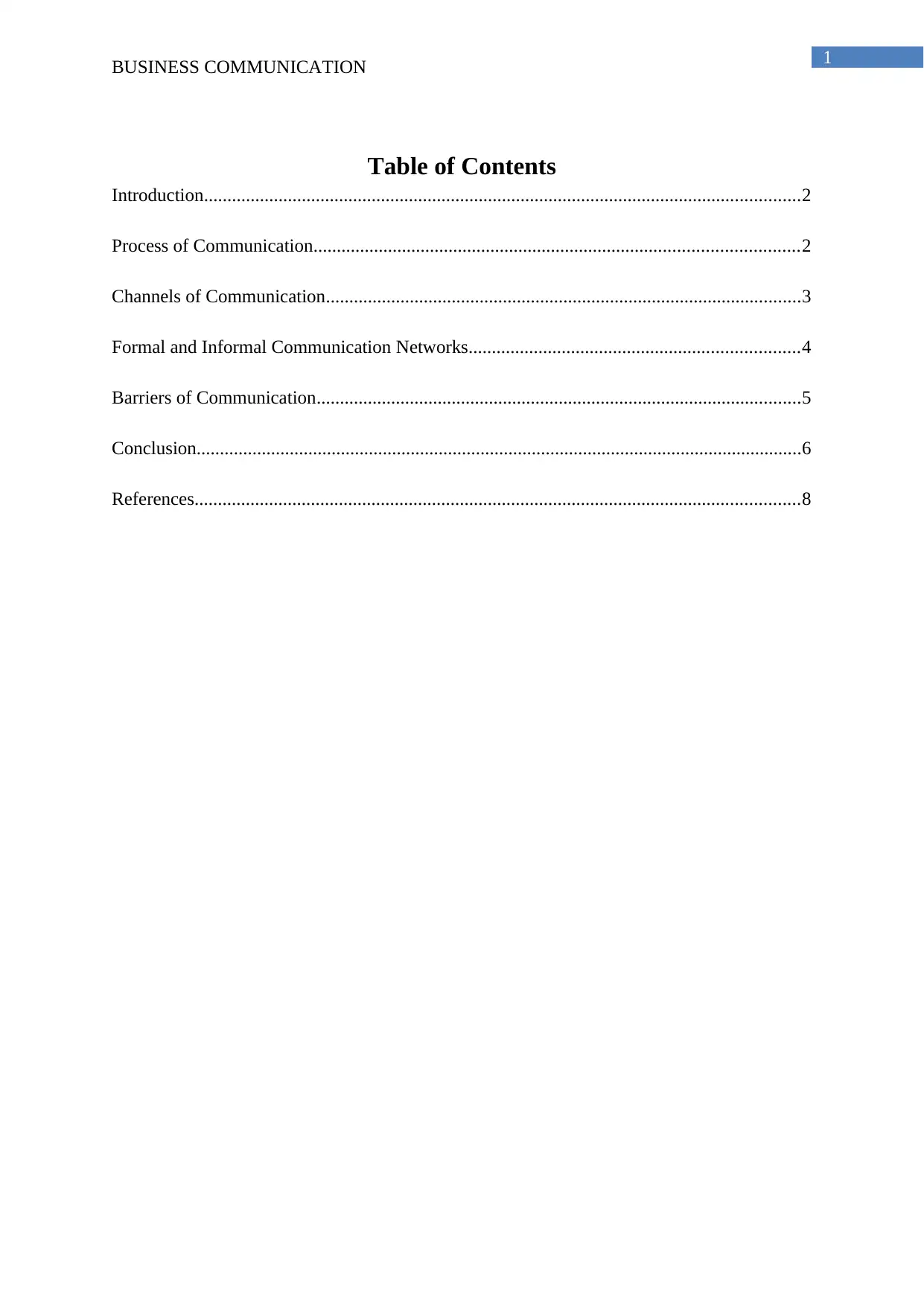
1
BUSINESS COMMUNICATION
Table of Contents
Introduction................................................................................................................................2
Process of Communication........................................................................................................2
Channels of Communication......................................................................................................3
Formal and Informal Communication Networks.......................................................................4
Barriers of Communication........................................................................................................5
Conclusion..................................................................................................................................6
References..................................................................................................................................8
BUSINESS COMMUNICATION
Table of Contents
Introduction................................................................................................................................2
Process of Communication........................................................................................................2
Channels of Communication......................................................................................................3
Formal and Informal Communication Networks.......................................................................4
Barriers of Communication........................................................................................................5
Conclusion..................................................................................................................................6
References..................................................................................................................................8
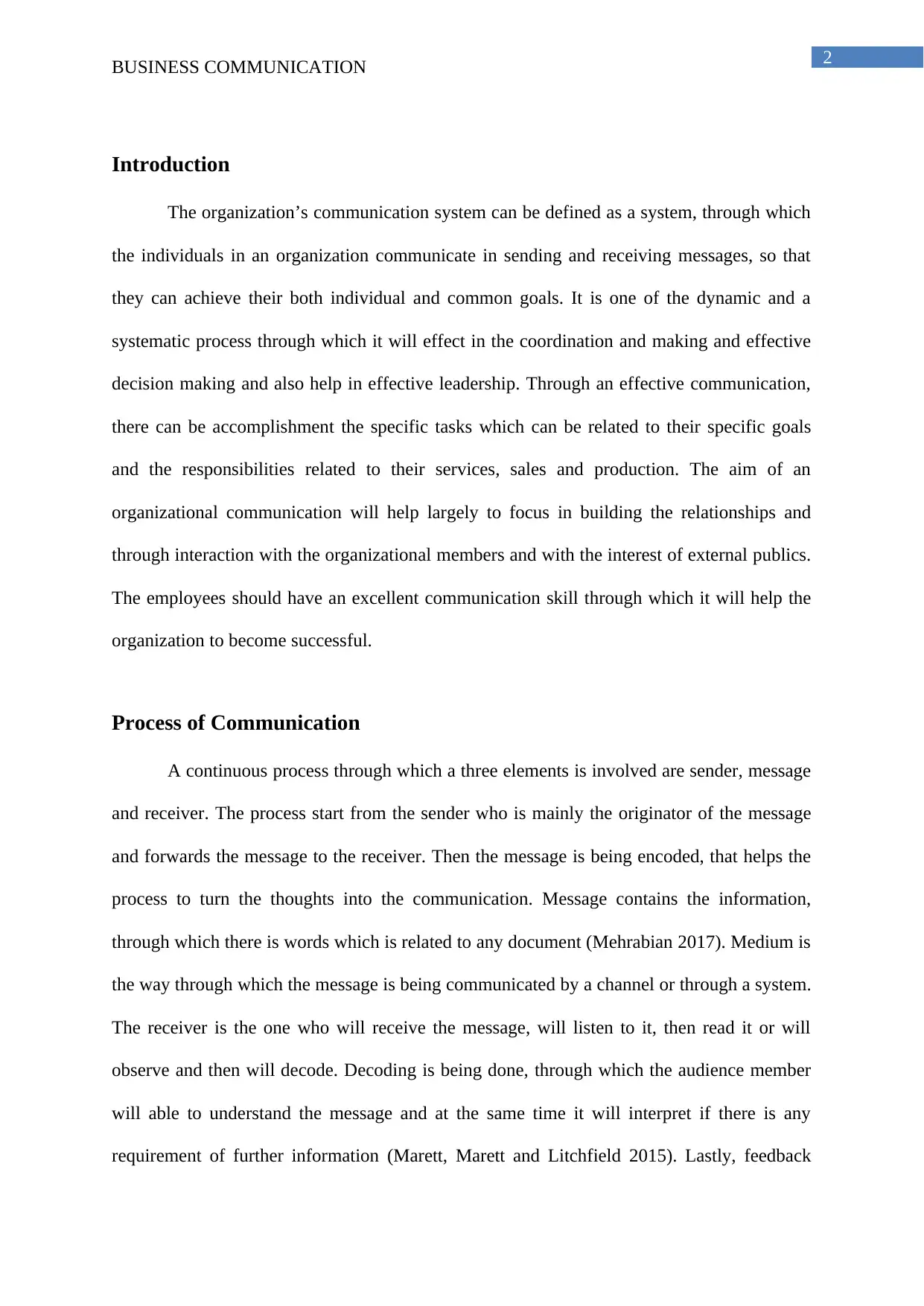
2
BUSINESS COMMUNICATION
Introduction
The organization’s communication system can be defined as a system, through which
the individuals in an organization communicate in sending and receiving messages, so that
they can achieve their both individual and common goals. It is one of the dynamic and a
systematic process through which it will effect in the coordination and making and effective
decision making and also help in effective leadership. Through an effective communication,
there can be accomplishment the specific tasks which can be related to their specific goals
and the responsibilities related to their services, sales and production. The aim of an
organizational communication will help largely to focus in building the relationships and
through interaction with the organizational members and with the interest of external publics.
The employees should have an excellent communication skill through which it will help the
organization to become successful.
Process of Communication
A continuous process through which a three elements is involved are sender, message
and receiver. The process start from the sender who is mainly the originator of the message
and forwards the message to the receiver. Then the message is being encoded, that helps the
process to turn the thoughts into the communication. Message contains the information,
through which there is words which is related to any document (Mehrabian 2017). Medium is
the way through which the message is being communicated by a channel or through a system.
The receiver is the one who will receive the message, will listen to it, then read it or will
observe and then will decode. Decoding is being done, through which the audience member
will able to understand the message and at the same time it will interpret if there is any
requirement of further information (Marett, Marett and Litchfield 2015). Lastly, feedback
BUSINESS COMMUNICATION
Introduction
The organization’s communication system can be defined as a system, through which
the individuals in an organization communicate in sending and receiving messages, so that
they can achieve their both individual and common goals. It is one of the dynamic and a
systematic process through which it will effect in the coordination and making and effective
decision making and also help in effective leadership. Through an effective communication,
there can be accomplishment the specific tasks which can be related to their specific goals
and the responsibilities related to their services, sales and production. The aim of an
organizational communication will help largely to focus in building the relationships and
through interaction with the organizational members and with the interest of external publics.
The employees should have an excellent communication skill through which it will help the
organization to become successful.
Process of Communication
A continuous process through which a three elements is involved are sender, message
and receiver. The process start from the sender who is mainly the originator of the message
and forwards the message to the receiver. Then the message is being encoded, that helps the
process to turn the thoughts into the communication. Message contains the information,
through which there is words which is related to any document (Mehrabian 2017). Medium is
the way through which the message is being communicated by a channel or through a system.
The receiver is the one who will receive the message, will listen to it, then read it or will
observe and then will decode. Decoding is being done, through which the audience member
will able to understand the message and at the same time it will interpret if there is any
requirement of further information (Marett, Marett and Litchfield 2015). Lastly, feedback
⊘ This is a preview!⊘
Do you want full access?
Subscribe today to unlock all pages.

Trusted by 1+ million students worldwide
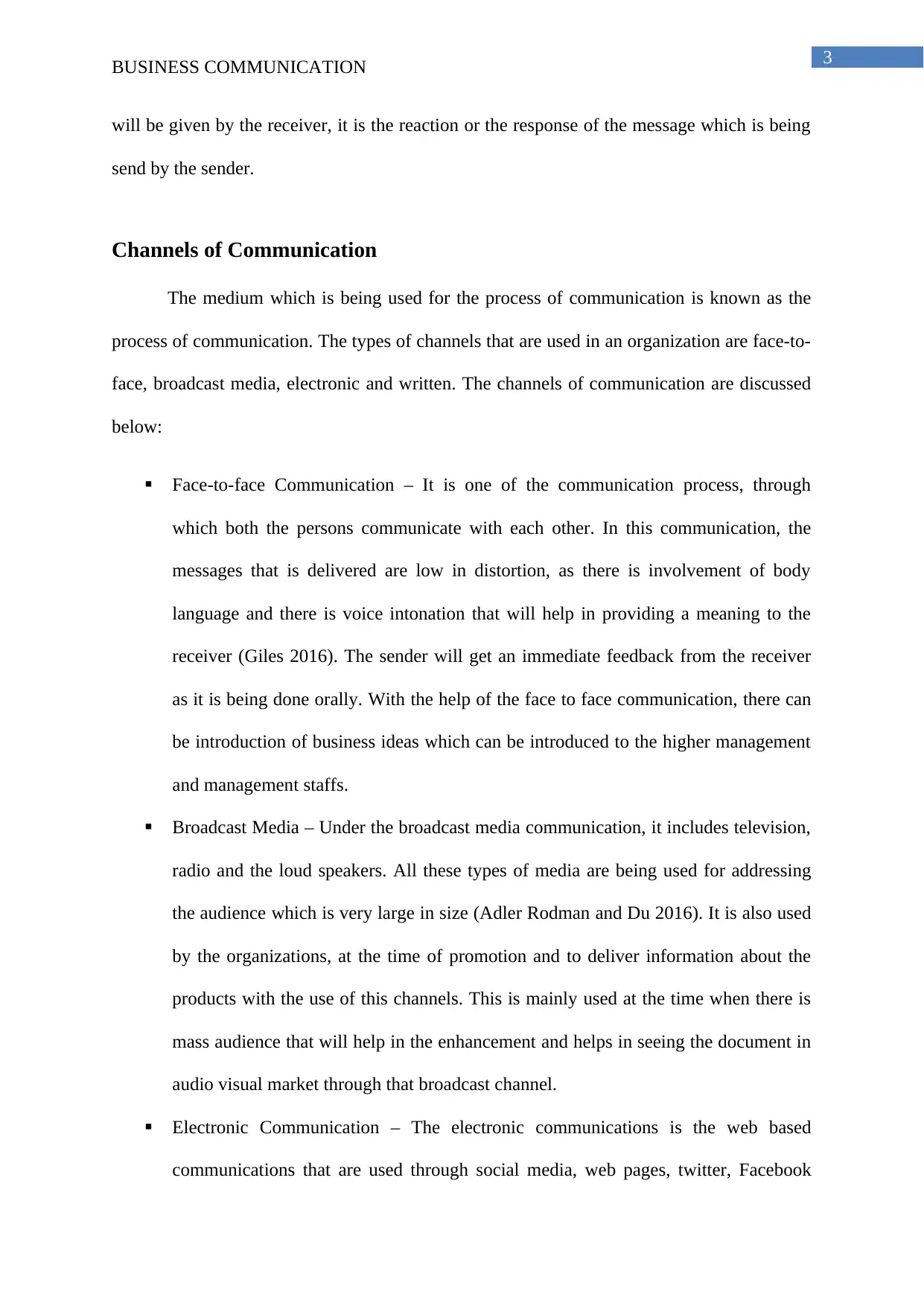
3
BUSINESS COMMUNICATION
will be given by the receiver, it is the reaction or the response of the message which is being
send by the sender.
Channels of Communication
The medium which is being used for the process of communication is known as the
process of communication. The types of channels that are used in an organization are face-to-
face, broadcast media, electronic and written. The channels of communication are discussed
below:
Face-to-face Communication – It is one of the communication process, through
which both the persons communicate with each other. In this communication, the
messages that is delivered are low in distortion, as there is involvement of body
language and there is voice intonation that will help in providing a meaning to the
receiver (Giles 2016). The sender will get an immediate feedback from the receiver
as it is being done orally. With the help of the face to face communication, there can
be introduction of business ideas which can be introduced to the higher management
and management staffs.
Broadcast Media – Under the broadcast media communication, it includes television,
radio and the loud speakers. All these types of media are being used for addressing
the audience which is very large in size (Adler Rodman and Du 2016). It is also used
by the organizations, at the time of promotion and to deliver information about the
products with the use of this channels. This is mainly used at the time when there is
mass audience that will help in the enhancement and helps in seeing the document in
audio visual market through that broadcast channel.
Electronic Communication – The electronic communications is the web based
communications that are used through social media, web pages, twitter, Facebook
BUSINESS COMMUNICATION
will be given by the receiver, it is the reaction or the response of the message which is being
send by the sender.
Channels of Communication
The medium which is being used for the process of communication is known as the
process of communication. The types of channels that are used in an organization are face-to-
face, broadcast media, electronic and written. The channels of communication are discussed
below:
Face-to-face Communication – It is one of the communication process, through
which both the persons communicate with each other. In this communication, the
messages that is delivered are low in distortion, as there is involvement of body
language and there is voice intonation that will help in providing a meaning to the
receiver (Giles 2016). The sender will get an immediate feedback from the receiver
as it is being done orally. With the help of the face to face communication, there can
be introduction of business ideas which can be introduced to the higher management
and management staffs.
Broadcast Media – Under the broadcast media communication, it includes television,
radio and the loud speakers. All these types of media are being used for addressing
the audience which is very large in size (Adler Rodman and Du 2016). It is also used
by the organizations, at the time of promotion and to deliver information about the
products with the use of this channels. This is mainly used at the time when there is
mass audience that will help in the enhancement and helps in seeing the document in
audio visual market through that broadcast channel.
Electronic Communication – The electronic communications is the web based
communications that are used through social media, web pages, twitter, Facebook
Paraphrase This Document
Need a fresh take? Get an instant paraphrase of this document with our AI Paraphraser
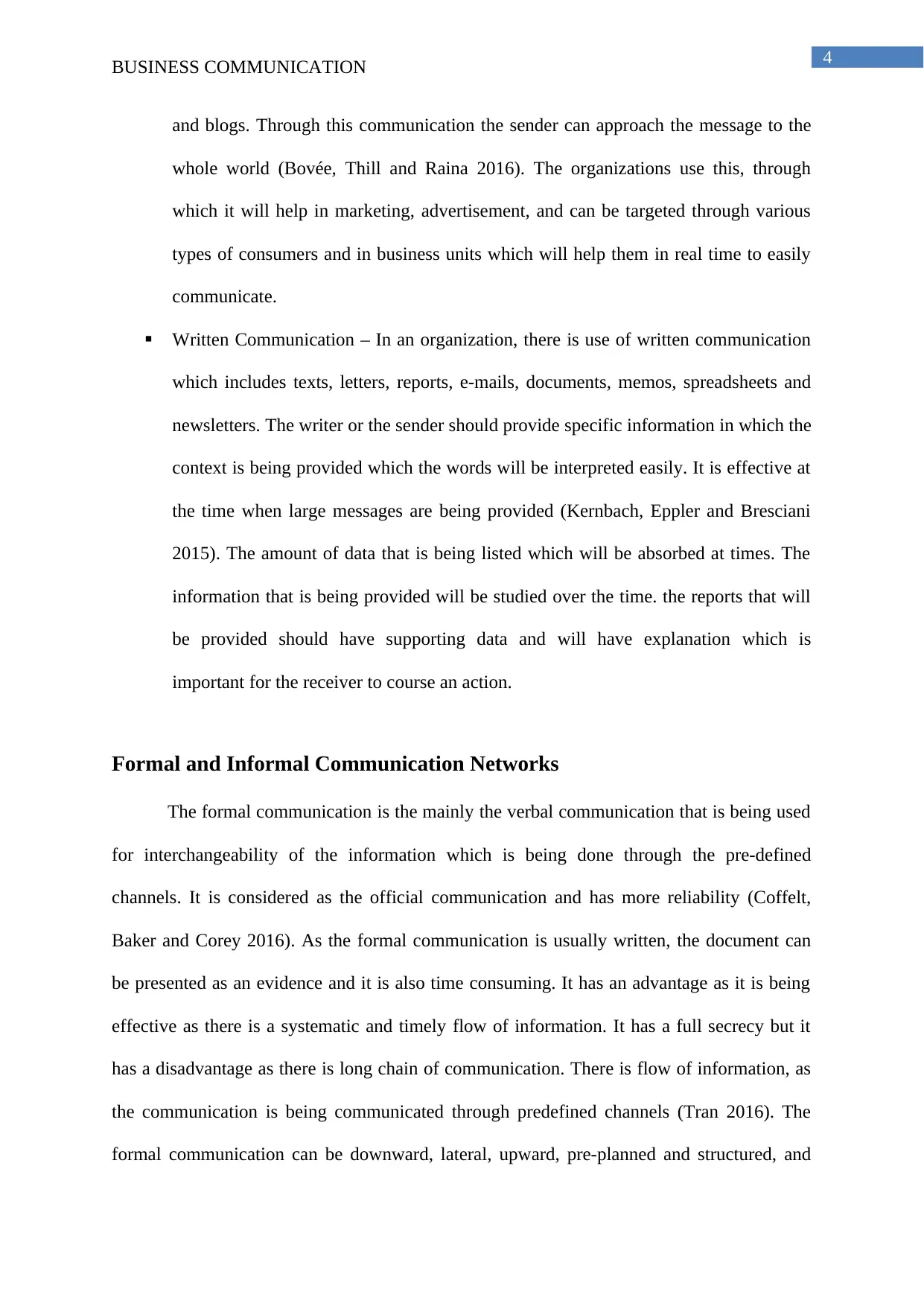
4
BUSINESS COMMUNICATION
and blogs. Through this communication the sender can approach the message to the
whole world (Bovée, Thill and Raina 2016). The organizations use this, through
which it will help in marketing, advertisement, and can be targeted through various
types of consumers and in business units which will help them in real time to easily
communicate.
Written Communication – In an organization, there is use of written communication
which includes texts, letters, reports, e-mails, documents, memos, spreadsheets and
newsletters. The writer or the sender should provide specific information in which the
context is being provided which the words will be interpreted easily. It is effective at
the time when large messages are being provided (Kernbach, Eppler and Bresciani
2015). The amount of data that is being listed which will be absorbed at times. The
information that is being provided will be studied over the time. the reports that will
be provided should have supporting data and will have explanation which is
important for the receiver to course an action.
Formal and Informal Communication Networks
The formal communication is the mainly the verbal communication that is being used
for interchangeability of the information which is being done through the pre-defined
channels. It is considered as the official communication and has more reliability (Coffelt,
Baker and Corey 2016). As the formal communication is usually written, the document can
be presented as an evidence and it is also time consuming. It has an advantage as it is being
effective as there is a systematic and timely flow of information. It has a full secrecy but it
has a disadvantage as there is long chain of communication. There is flow of information, as
the communication is being communicated through predefined channels (Tran 2016). The
formal communication can be downward, lateral, upward, pre-planned and structured, and
BUSINESS COMMUNICATION
and blogs. Through this communication the sender can approach the message to the
whole world (Bovée, Thill and Raina 2016). The organizations use this, through
which it will help in marketing, advertisement, and can be targeted through various
types of consumers and in business units which will help them in real time to easily
communicate.
Written Communication – In an organization, there is use of written communication
which includes texts, letters, reports, e-mails, documents, memos, spreadsheets and
newsletters. The writer or the sender should provide specific information in which the
context is being provided which the words will be interpreted easily. It is effective at
the time when large messages are being provided (Kernbach, Eppler and Bresciani
2015). The amount of data that is being listed which will be absorbed at times. The
information that is being provided will be studied over the time. the reports that will
be provided should have supporting data and will have explanation which is
important for the receiver to course an action.
Formal and Informal Communication Networks
The formal communication is the mainly the verbal communication that is being used
for interchangeability of the information which is being done through the pre-defined
channels. It is considered as the official communication and has more reliability (Coffelt,
Baker and Corey 2016). As the formal communication is usually written, the document can
be presented as an evidence and it is also time consuming. It has an advantage as it is being
effective as there is a systematic and timely flow of information. It has a full secrecy but it
has a disadvantage as there is long chain of communication. There is flow of information, as
the communication is being communicated through predefined channels (Tran 2016). The
formal communication can be downward, lateral, upward, pre-planned and structured, and
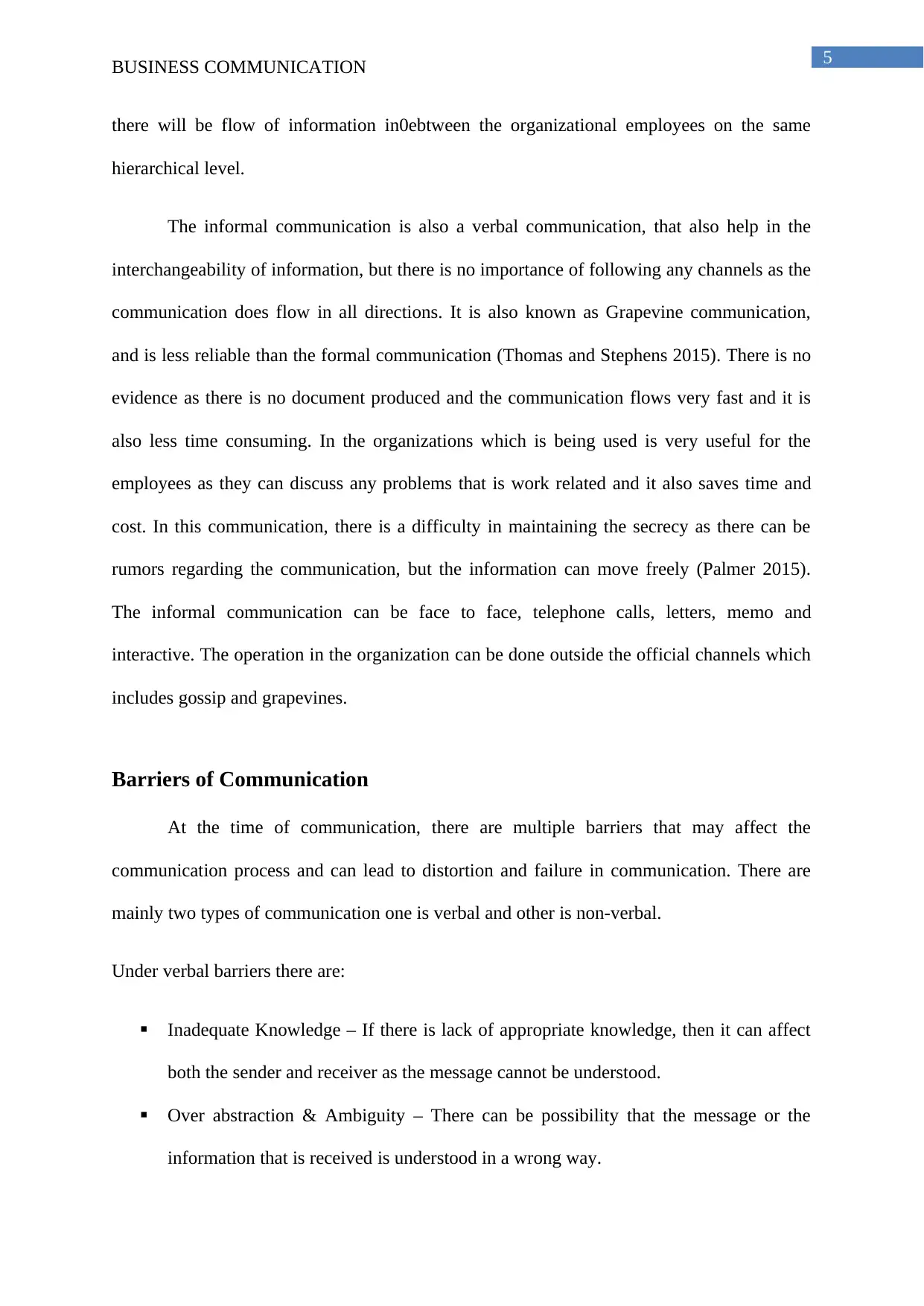
5
BUSINESS COMMUNICATION
there will be flow of information in0ebtween the organizational employees on the same
hierarchical level.
The informal communication is also a verbal communication, that also help in the
interchangeability of information, but there is no importance of following any channels as the
communication does flow in all directions. It is also known as Grapevine communication,
and is less reliable than the formal communication (Thomas and Stephens 2015). There is no
evidence as there is no document produced and the communication flows very fast and it is
also less time consuming. In the organizations which is being used is very useful for the
employees as they can discuss any problems that is work related and it also saves time and
cost. In this communication, there is a difficulty in maintaining the secrecy as there can be
rumors regarding the communication, but the information can move freely (Palmer 2015).
The informal communication can be face to face, telephone calls, letters, memo and
interactive. The operation in the organization can be done outside the official channels which
includes gossip and grapevines.
Barriers of Communication
At the time of communication, there are multiple barriers that may affect the
communication process and can lead to distortion and failure in communication. There are
mainly two types of communication one is verbal and other is non-verbal.
Under verbal barriers there are:
Inadequate Knowledge – If there is lack of appropriate knowledge, then it can affect
both the sender and receiver as the message cannot be understood.
Over abstraction & Ambiguity – There can be possibility that the message or the
information that is received is understood in a wrong way.
BUSINESS COMMUNICATION
there will be flow of information in0ebtween the organizational employees on the same
hierarchical level.
The informal communication is also a verbal communication, that also help in the
interchangeability of information, but there is no importance of following any channels as the
communication does flow in all directions. It is also known as Grapevine communication,
and is less reliable than the formal communication (Thomas and Stephens 2015). There is no
evidence as there is no document produced and the communication flows very fast and it is
also less time consuming. In the organizations which is being used is very useful for the
employees as they can discuss any problems that is work related and it also saves time and
cost. In this communication, there is a difficulty in maintaining the secrecy as there can be
rumors regarding the communication, but the information can move freely (Palmer 2015).
The informal communication can be face to face, telephone calls, letters, memo and
interactive. The operation in the organization can be done outside the official channels which
includes gossip and grapevines.
Barriers of Communication
At the time of communication, there are multiple barriers that may affect the
communication process and can lead to distortion and failure in communication. There are
mainly two types of communication one is verbal and other is non-verbal.
Under verbal barriers there are:
Inadequate Knowledge – If there is lack of appropriate knowledge, then it can affect
both the sender and receiver as the message cannot be understood.
Over abstraction & Ambiguity – There can be possibility that the message or the
information that is received is understood in a wrong way.
⊘ This is a preview!⊘
Do you want full access?
Subscribe today to unlock all pages.

Trusted by 1+ million students worldwide
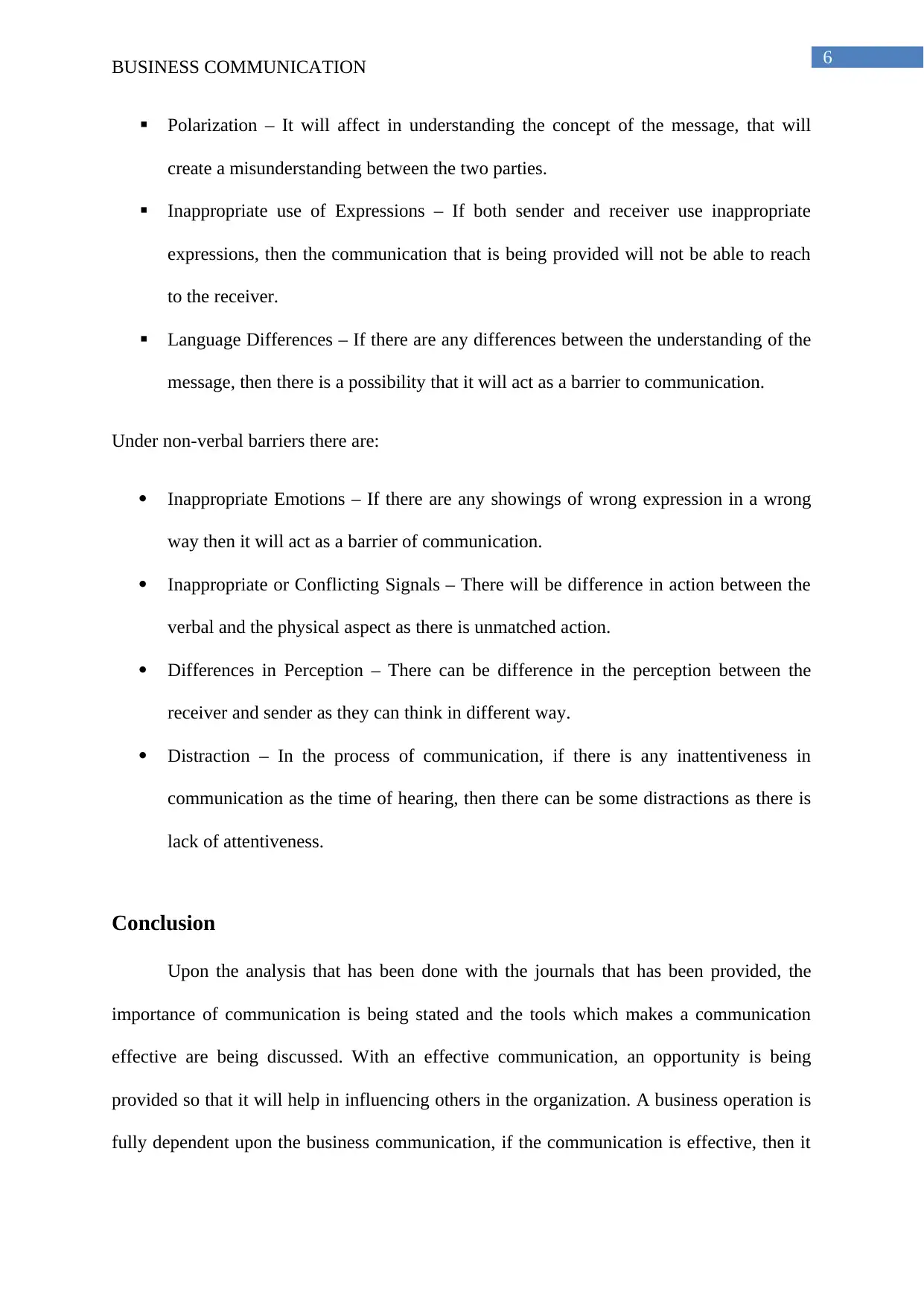
6
BUSINESS COMMUNICATION
Polarization – It will affect in understanding the concept of the message, that will
create a misunderstanding between the two parties.
Inappropriate use of Expressions – If both sender and receiver use inappropriate
expressions, then the communication that is being provided will not be able to reach
to the receiver.
Language Differences – If there are any differences between the understanding of the
message, then there is a possibility that it will act as a barrier to communication.
Under non-verbal barriers there are:
Inappropriate Emotions – If there are any showings of wrong expression in a wrong
way then it will act as a barrier of communication.
Inappropriate or Conflicting Signals – There will be difference in action between the
verbal and the physical aspect as there is unmatched action.
Differences in Perception – There can be difference in the perception between the
receiver and sender as they can think in different way.
Distraction – In the process of communication, if there is any inattentiveness in
communication as the time of hearing, then there can be some distractions as there is
lack of attentiveness.
Conclusion
Upon the analysis that has been done with the journals that has been provided, the
importance of communication is being stated and the tools which makes a communication
effective are being discussed. With an effective communication, an opportunity is being
provided so that it will help in influencing others in the organization. A business operation is
fully dependent upon the business communication, if the communication is effective, then it
BUSINESS COMMUNICATION
Polarization – It will affect in understanding the concept of the message, that will
create a misunderstanding between the two parties.
Inappropriate use of Expressions – If both sender and receiver use inappropriate
expressions, then the communication that is being provided will not be able to reach
to the receiver.
Language Differences – If there are any differences between the understanding of the
message, then there is a possibility that it will act as a barrier to communication.
Under non-verbal barriers there are:
Inappropriate Emotions – If there are any showings of wrong expression in a wrong
way then it will act as a barrier of communication.
Inappropriate or Conflicting Signals – There will be difference in action between the
verbal and the physical aspect as there is unmatched action.
Differences in Perception – There can be difference in the perception between the
receiver and sender as they can think in different way.
Distraction – In the process of communication, if there is any inattentiveness in
communication as the time of hearing, then there can be some distractions as there is
lack of attentiveness.
Conclusion
Upon the analysis that has been done with the journals that has been provided, the
importance of communication is being stated and the tools which makes a communication
effective are being discussed. With an effective communication, an opportunity is being
provided so that it will help in influencing others in the organization. A business operation is
fully dependent upon the business communication, if the communication is effective, then it
Paraphrase This Document
Need a fresh take? Get an instant paraphrase of this document with our AI Paraphraser
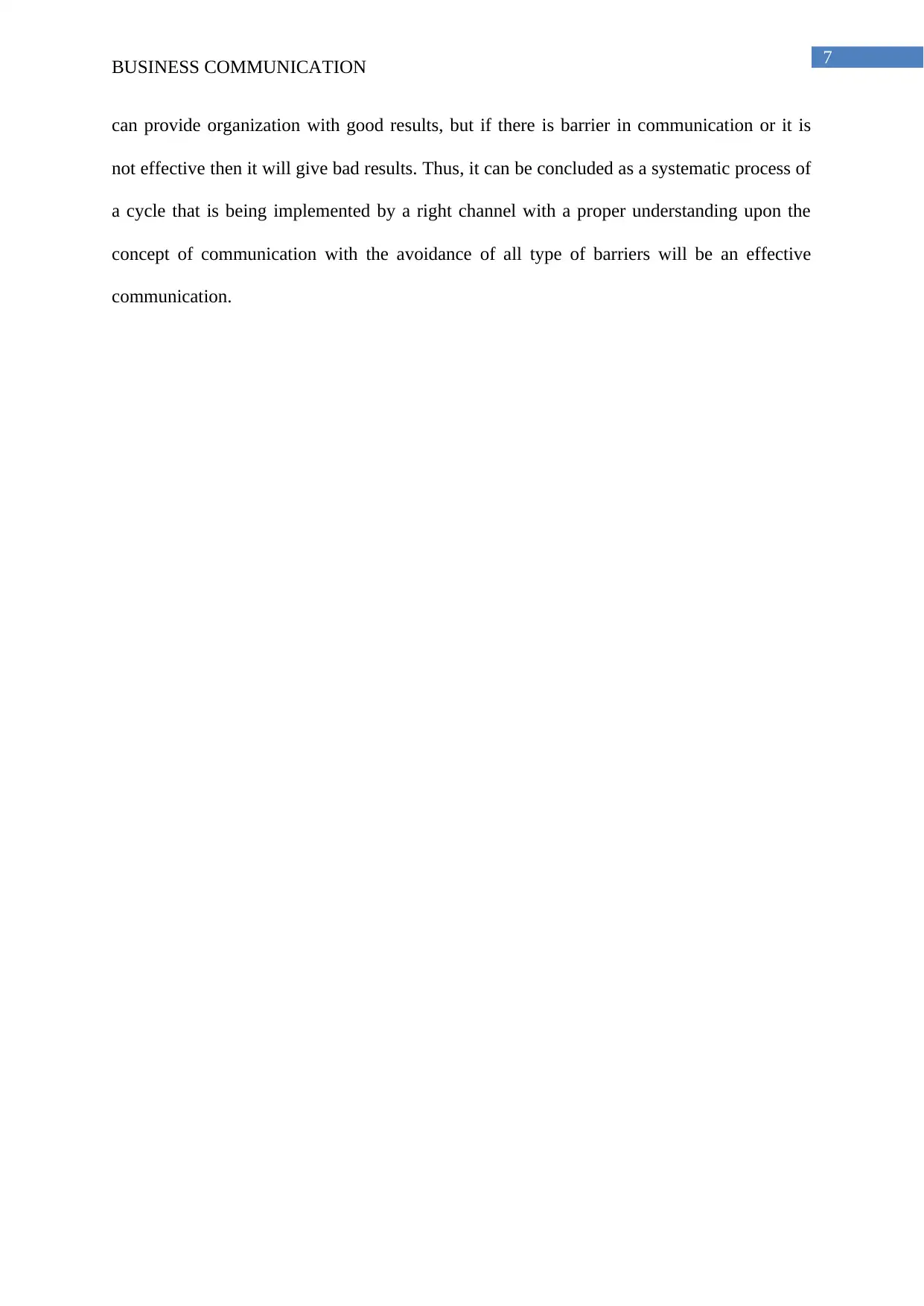
7
BUSINESS COMMUNICATION
can provide organization with good results, but if there is barrier in communication or it is
not effective then it will give bad results. Thus, it can be concluded as a systematic process of
a cycle that is being implemented by a right channel with a proper understanding upon the
concept of communication with the avoidance of all type of barriers will be an effective
communication.
BUSINESS COMMUNICATION
can provide organization with good results, but if there is barrier in communication or it is
not effective then it will give bad results. Thus, it can be concluded as a systematic process of
a cycle that is being implemented by a right channel with a proper understanding upon the
concept of communication with the avoidance of all type of barriers will be an effective
communication.
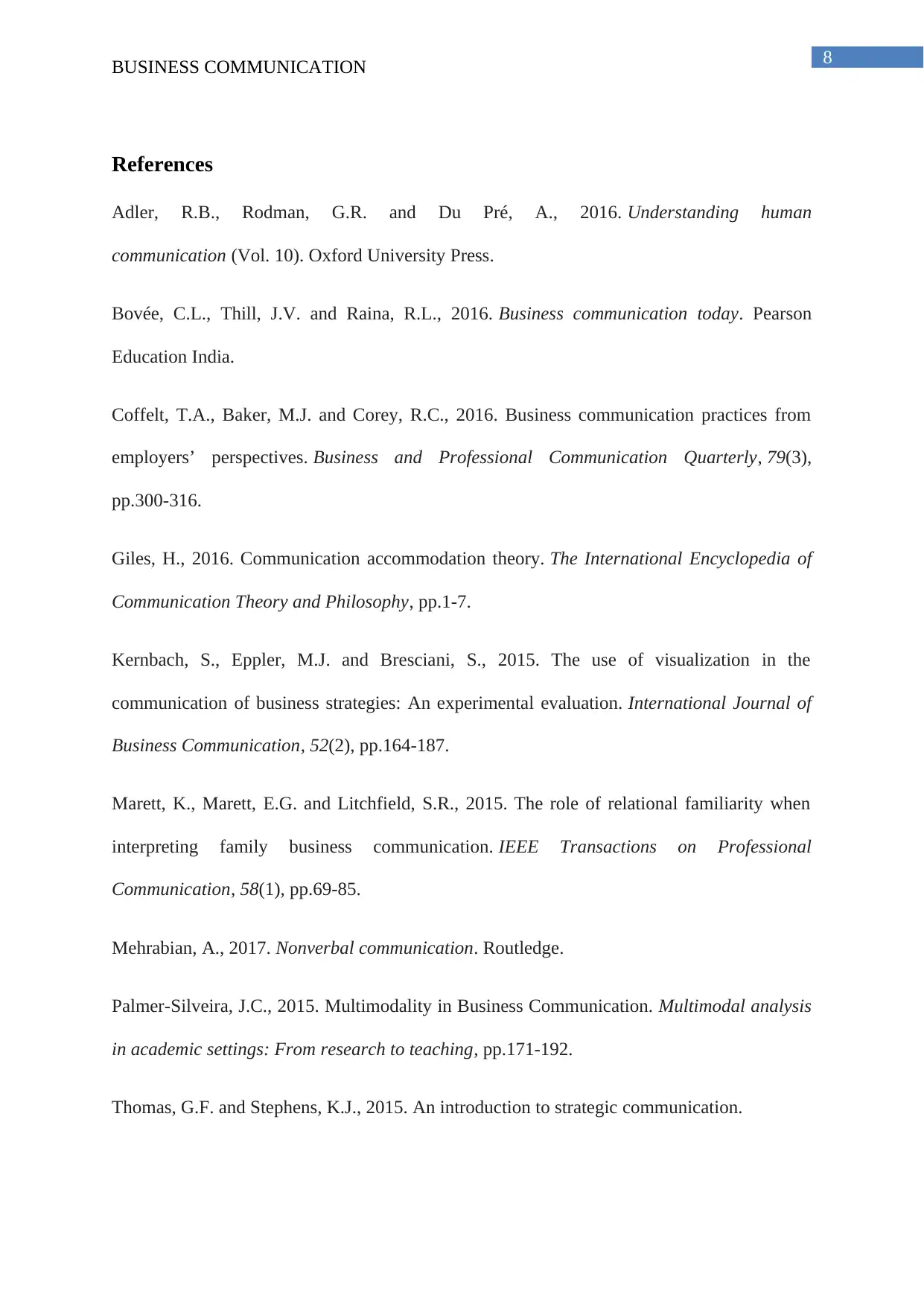
8
BUSINESS COMMUNICATION
References
Adler, R.B., Rodman, G.R. and Du Pré, A., 2016. Understanding human
communication (Vol. 10). Oxford University Press.
Bovée, C.L., Thill, J.V. and Raina, R.L., 2016. Business communication today. Pearson
Education India.
Coffelt, T.A., Baker, M.J. and Corey, R.C., 2016. Business communication practices from
employers’ perspectives. Business and Professional Communication Quarterly, 79(3),
pp.300-316.
Giles, H., 2016. Communication accommodation theory. The International Encyclopedia of
Communication Theory and Philosophy, pp.1-7.
Kernbach, S., Eppler, M.J. and Bresciani, S., 2015. The use of visualization in the
communication of business strategies: An experimental evaluation. International Journal of
Business Communication, 52(2), pp.164-187.
Marett, K., Marett, E.G. and Litchfield, S.R., 2015. The role of relational familiarity when
interpreting family business communication. IEEE Transactions on Professional
Communication, 58(1), pp.69-85.
Mehrabian, A., 2017. Nonverbal communication. Routledge.
Palmer-Silveira, J.C., 2015. Multimodality in Business Communication. Multimodal analysis
in academic settings: From research to teaching, pp.171-192.
Thomas, G.F. and Stephens, K.J., 2015. An introduction to strategic communication.
BUSINESS COMMUNICATION
References
Adler, R.B., Rodman, G.R. and Du Pré, A., 2016. Understanding human
communication (Vol. 10). Oxford University Press.
Bovée, C.L., Thill, J.V. and Raina, R.L., 2016. Business communication today. Pearson
Education India.
Coffelt, T.A., Baker, M.J. and Corey, R.C., 2016. Business communication practices from
employers’ perspectives. Business and Professional Communication Quarterly, 79(3),
pp.300-316.
Giles, H., 2016. Communication accommodation theory. The International Encyclopedia of
Communication Theory and Philosophy, pp.1-7.
Kernbach, S., Eppler, M.J. and Bresciani, S., 2015. The use of visualization in the
communication of business strategies: An experimental evaluation. International Journal of
Business Communication, 52(2), pp.164-187.
Marett, K., Marett, E.G. and Litchfield, S.R., 2015. The role of relational familiarity when
interpreting family business communication. IEEE Transactions on Professional
Communication, 58(1), pp.69-85.
Mehrabian, A., 2017. Nonverbal communication. Routledge.
Palmer-Silveira, J.C., 2015. Multimodality in Business Communication. Multimodal analysis
in academic settings: From research to teaching, pp.171-192.
Thomas, G.F. and Stephens, K.J., 2015. An introduction to strategic communication.
⊘ This is a preview!⊘
Do you want full access?
Subscribe today to unlock all pages.

Trusted by 1+ million students worldwide
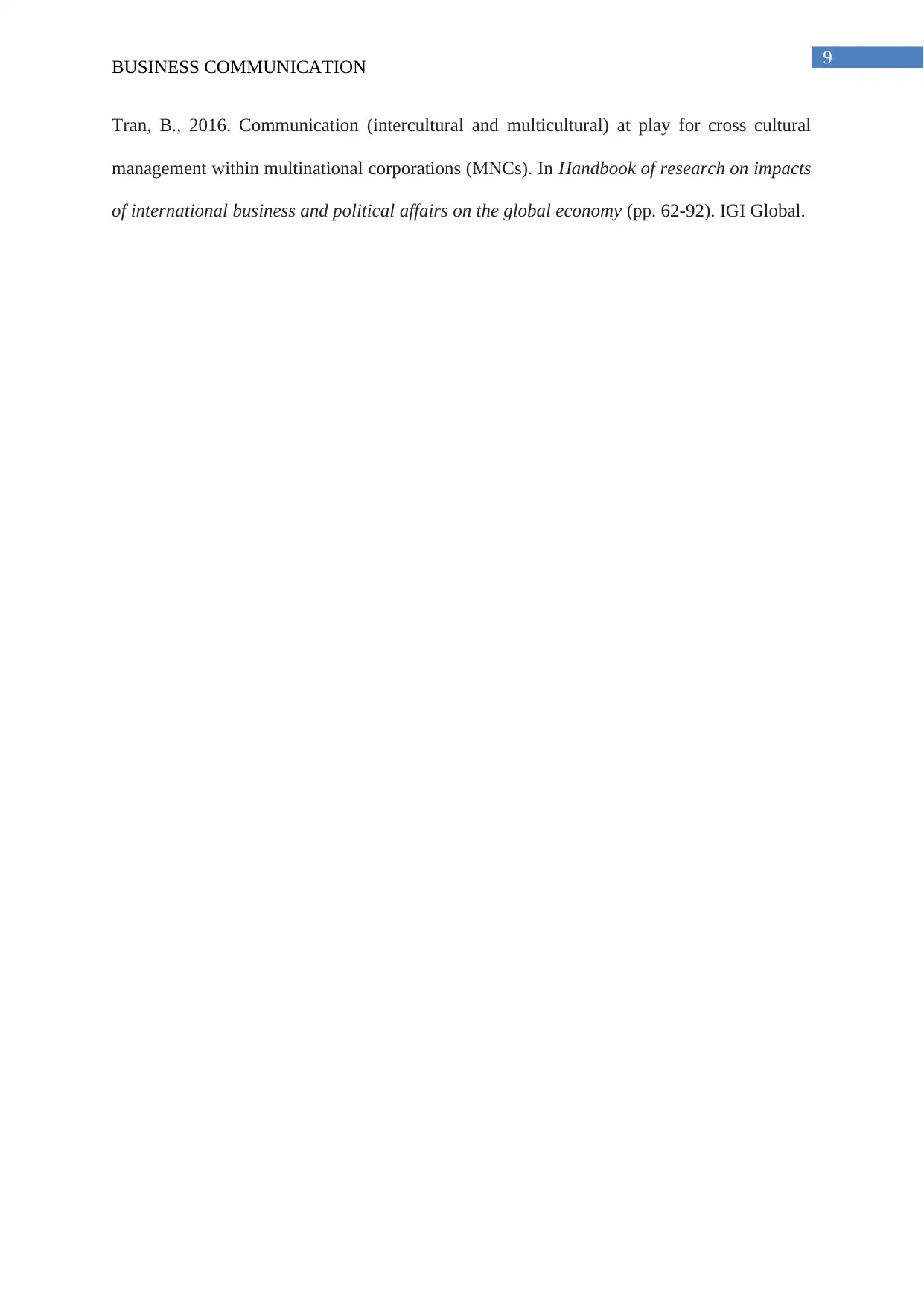
9
BUSINESS COMMUNICATION
Tran, B., 2016. Communication (intercultural and multicultural) at play for cross cultural
management within multinational corporations (MNCs). In Handbook of research on impacts
of international business and political affairs on the global economy (pp. 62-92). IGI Global.
BUSINESS COMMUNICATION
Tran, B., 2016. Communication (intercultural and multicultural) at play for cross cultural
management within multinational corporations (MNCs). In Handbook of research on impacts
of international business and political affairs on the global economy (pp. 62-92). IGI Global.
1 out of 10
Related Documents
Your All-in-One AI-Powered Toolkit for Academic Success.
+13062052269
info@desklib.com
Available 24*7 on WhatsApp / Email
![[object Object]](/_next/static/media/star-bottom.7253800d.svg)
Unlock your academic potential
Copyright © 2020–2025 A2Z Services. All Rights Reserved. Developed and managed by ZUCOL.





